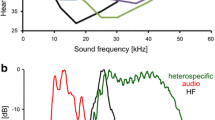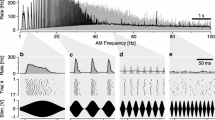Summary
-
1.
Eigenmannia can detect modulations in the time disparity of signals received by different regions of the body surface as small as several hundred nanoseconds. This study presents recordings of single units in the torus semicircularis that are sensitive to time disparities (differential-phase) between a sinusoidal signal received by the head region and a similar signal received by the body surface caudal to the fish's pectoral fins.
-
2.
The sensitivity of units to differential phase, measured by the change in spike rate per unit change in time disparity, was greatest when small phase modulations, rather than stationary phase differences, were presented. Thresholds of differentialphase coders ranged from 6.5 μs to several hundred microseconds, with approxiamtely 20% of the units having thresholds in the 5–10 μs range. For most cells, sensitivity to small modulations of differential-phase was relatively unaffected by time disparity ‘offsets’ within a range of several hundred microseconds. A threshold of 5–10 μs is still an order of magnitude higher than that measured in the Jamming Avoidance Response (JAR).
-
3.
Neurons that were sensitive to amplitude modulations (AMs) had thresholds as low as 0.05%. This value is comparable to that observed at the behavioral level.
Similar content being viewed by others
References
Bastian J (1981) Electrolocation II. The effects of moving objects and other electrical stimuli on the activities of two categories of posterior lateral line lobe cells inApteronotus albifrons. J Comp Physiol 144:481–494
Bastian J, Heiligenberg W (1980) Neural correlates of the jamming avoidance response inEigenmannia. J Comp Physiol 136:135–152
Bullock TH, Hamstra RH, Scheich H (1972) The jamming avoidance response of high frequency electric fish. J Comp Physiol 77:1–48
Carr CE, Maler L, Heiligenberg W, Sas E (1981) Laminar organization of the afferent and efferent systems of the torus semicircularis of gymnotiform fish: Morphological substrates for parallel processing in the electrosensory system. J Comp Neurol 203:649–670
Carr CE, Heiligenberg W, Rose G (1986a) A time comparison circuit in the electric fish midbrain: I. Behavior and neurophysiology. J Neurosci 6:107–119
Carr CE, Maler L, Taylor B (1986) A time comparison circuit in the electric fish midbrain. II. Functional morphology. J Neurosci 6:1372–1383
Frank K, Becker MC (1964) Microelectrodes for recording and stimulation. In: Nastuk WL (ed) Physical techniques in biological research, vol 5, part A. Academic Press, New York, pp 23–84
Harnischfeger G, Neuweiler G, Schlegel P (1985) Interaural time and intensity coding in superior olive complex and inferior colliculus of the echolocating batMolossus ater. J Neurophysiol 53:89–109
Heiligenberg W, Bastian J (1980) The control ofEigenmannia's pacemaker by a distributed evaluation of electroreceptive afferences. J Comp Physiol 136:113–133
Heiligenberg W, Bastian J (1984) The electric sense of weakly electric fish. Annu Rev Physiol 46:561–583
Heiligenberg W, Dye J (1982) Labelling of electroreceptive afferences in a gymnotoid fish by intracellular injection of HRP: The mystery of multiple maps. J Comp Physiol 127:287–296
Heiligenberg W, Rose G (1985) Phase and amplitude computations in the midbrain of an electric fish: Intracellular studies of neurons participating in the jamming avoidance response ofEigenmannia. J Neurosci 5:515–531
Heiligenberg W, Baker C, Matsubara J (1978) The jamming avoidance response inEigenmannia revisited: The structure of a neuronal democracy. J Comp Physiol 127:267–286
Maler L, Sas E, Rogers J (1981) The cytology of the posterior lateral line lobe of high frequency weakly electric fish (Gymnotoidei): Dendritic differentiation and synaptic specificity in a simple cortex. J Comp Neurol 195:87–139
Mathieson WB, Heiligenberg W, Maler L (1986) Ultrastructural studies of physiologically identified electrosensory afferent synapses in the gymnotiform fish,Eigenmannia. J Comp Neurol (in press)
Moiseff A, Konishi M (1981) Neuronal and behavioral sensitivity to binaural time differences in the owl. J Neurosci 1:40–48
Moiseff A, Konishi M (1983) Binaural characteristics of units in the owl's brainstem auditory pathways: Precursors of restricted spatial receptive fields. J Neurosci 3:2553–2562
Partridge BL, Heiligenberg W, Matsubara J (1981) The neural basis of a sensory filter in the jamming avoidance response: No grandmother cells in sight. J Comp Physiol 145:153–168
Rose G, Heiligenberg W (1985a) Structure and function of electrosensory neurons in the torus semicircularis ofEigenmannia: Morphological correlates of phase and amplitude sensitivity. J Neurosci 5:2269–2280
Rose G, Heiligenberg W (1985b) Temporal hyperacuity in the electric sense of fish. Nature 318:178–180
Saunders J, Bastian J (1984) The physiology and morphology of two types of electrosensory neurons in the weakly electric fishApteronotus leptorhynchus. J Comp Physiol A 154:199–211
Simmons J (1979) Perception of echo phase information in bat sonar. Science 204:1336–1338
Westheimer G (1979) The spatial sense of the eye. Invest Ophthal Visual Sci 18:893–912
Westheimer G (1981) Visual hyperacuity. Prog Sensory Physiol 1:1–30
Yin TCT, Kuwada S (1983 a) Binaural interaction in low-frequency neurons in the inferior colliculus of the cat. II. Effects of changing rate and direction of interaural phase. J Neurophysiol 50:1000–1019
Yin TCT, Kuwada S (1983b) Binaural interaction in low-frequency neurons in the inferior colliculus of the cat. III. Effects of changing frequency. J Neurophysiol 50:1020–1042
Author information
Authors and Affiliations
Rights and permissions
About this article
Cite this article
Rose, G., Heiligenberg, W. Limits of phase and amplitude sensitivity in the torus semicircularis ofEigenmannia . J. Comp. Physiol. 159, 813–822 (1986). https://doi.org/10.1007/BF00603734
Accepted:
Issue Date:
DOI: https://doi.org/10.1007/BF00603734




